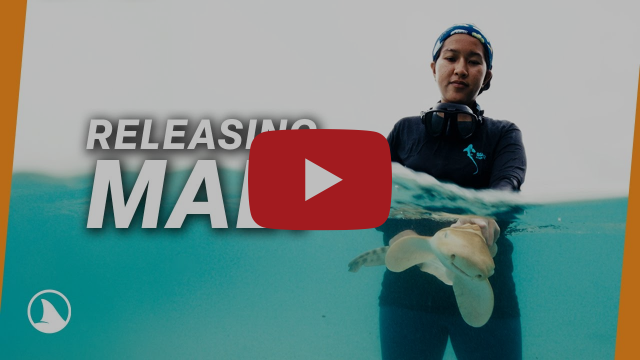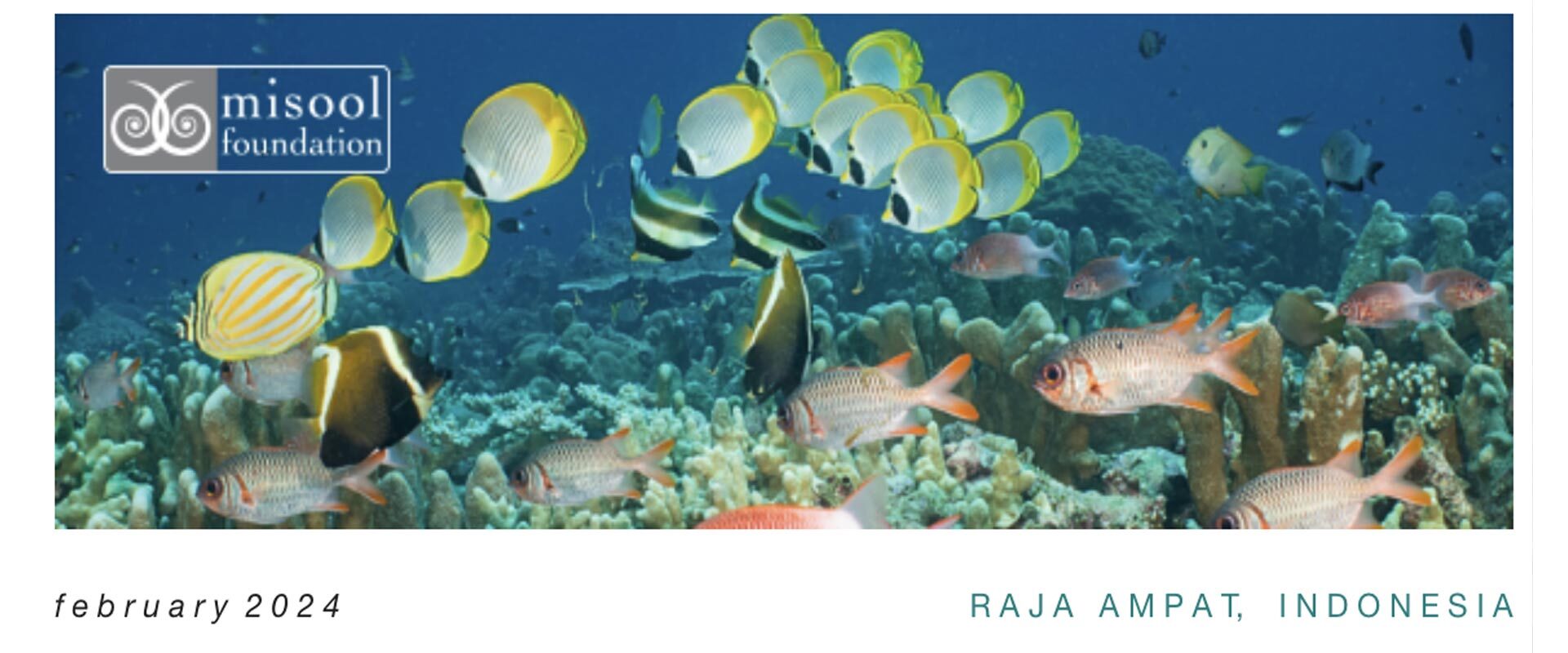The Science Special
This one is for the fish geeks and nature nerds among us. Read on for science and conservation news from the Misool Marine Reserve.
- ReShark: Everything You Need to Know
- Meet Kyra: Misool Foundation’s Resident Shark Nanny
- News in Brief
- Sail Raja Ampat this May and Raise Funds for Misool Foundation
- REEF Surveys Record 775 Species of Fish in Misool!
- How AI Can Save Coral
|
|
| ReShark: Everything You Need to Know |
|
|
Have you heard of the first-of-its-kind marine rewilding project that is reintroducing Leopard sharks in Raja Ampat? Allow us to introduce ReShark.
ReShark is an international collective of over 90 conservation organisations, aquariums and government agencies with one mission: to reintroduceendangered sharks to the wild.
The first iteration of this is the StAR Project and is focused on reintroducing Indo Pacific Leopard sharks (Stegostoma tigrinum – also known as Zebra sharks in some regions) to Raja Ampat.
|
|
| Why is ReShark Important?
Leopard sharks are listed as endangered by The International Union for the Conservation of Nature.
In Raja Ampat, Leopard sharks have been largely extirpated by intensive shark finning and are now functionally extinct.
That means that without ReShark, Leopard sharks will not return to Raja Ampat in our lifetime.
Raja Ampat was chosen due to its extensive Marine Protected Area network and there are two nursery locations, one of which is at Misool Resort. |
|
| 1. Shark eggs are laid in an aquarium. Breeders ensure that the parent sharks are of genetically appropriate brood stock from the Eastern Indonesian-Oceania subpopulation. This is important as it ensures a healthy and resilient wild Leopard shark population. |
|
|
2. Eggs are carefully packed and then flown to Indonesia. Upon arrival, eggs undergo inspection and quarantine before continuing their journey to Raja Ampat.
|
|
|
|
3. Eggs are transferred to our purpose-built nursery and cared for by our on-site aquarists or ‘Shark Nannies’ – Kyra and Agi. We currently have 10 eggs in our nursery that have travelled from Cairns in Australia. Misool Resort guests can pop in to see the nursery and ask the Shark Nannies all their questions.
|
|
|
|
4. When the pups hatch they are handfed sea snails, and about one week after hatching, theircolouration begins to shift from black and white stripes (hence the name Zebra shark in some countries) to the characteristic brown and beige leopard pattern.
|
|
|
5. Pups stay in the nursery until they reach the correct size and weight to be transferred to our in-water sea pen. While the pups acclimatise to their new habitat, the Shark Nannies continue to supplement their food and carefully monitor their development. Once the pups are of a suitable size and weight, they are fitted with a tiny acoustic tag so we can follow their movements.
|
|
|
6. Pups are released into the wild. The Misool Marine Reserve is well protected by the Misool Rangers, so we can release the sharks directly into the waters around Misool Resort. This is an ambitious programme and the first of its kind. The goal is to release 500 sharks to reach a self-sustaining population.
|
|
|
7. Leopard shark populations bounce back! We released our first shark, Mali, in July 2023, and we hope to soon have 10 more sharks to release.
A secondary goal is to learn everything we can about how to use captive-bred broodstock to safeguard wild populations, then apply this knowledge to other endangered shark and ray species.
|
|
|
| Check out these pages to learn more about this ground breaking project: |
|
 |
| WATCH: Releasing Mali into the Wild |
|
|
New Wildlife Documentary Series Featuring ReShark
|
|
|
If you have access to BBC’s iPlayer, you can watch The Coral Triangle episode of Wilderness with Simon Reeve which sees Simon visit Misool, meet the Rangers and get an introduction to two of the Leopard shark pups from the project’s Co-Chair, Nesha Ichida.
|
|
| Meet Kyra: Misool Foundation’s Resident Shark Nanny |
|
|
We are excited to introduce you to Kyra Bestari, Misool Foundation’s resident ReShark nanny and marine scientist.
Kyra joined Misool Foundation almost three years ago. She is our shark guru – caring for Leopard shark pups and monitoring shark populations using BRUVS (Baited Remote Underwater Video Surveys). She also assists with Reef Restoration Project.
If you have seen the recent Disney series Animals up Close with Bertie Gregory series, Episode 6, you’ve already caught a glimpse of Kyra in the field!
|
|
|
Kyra grew up in the urban sprawl of Jakarta and her inner-city start gave her a deep appreciation for nature. “In Jakarta I studied biology and took my first diving course in 2017,” she explains, but “saw absolutely nothing apart from rubble and a few fish.” This disappointing experience led her to conservation. She began researching microplastics and conducted a small study in Misool. Kyra then joined Misool Foundation’s internship programme.
Today Kyra has a one-of-a-kind job as a Shark Nanny. She starts her day in the nursery where she checks the Leopard shark eggs to monitor and maintain their development, then goes on to care for the babies that have already hatched. “I check them and feed them when they’re babies, talk to them a bit, and clean their tanks. My days change constantly depending on the life cycle of the baby sharks and whether there are any eggs or not. The fun part is when I need to dive into the sea-pen together with the babies to feed them 3-4 times a day.”
|
|
|
“Being in Misool is truly the biggest privilege I have ever had. Protected waters, abundant marine life, seeing baby sharks in our ‘front yard’, lovely communities.” It’s given Kyra a lot of ‘firsts’ too: “The first time I saw mantas at Magic Mountain I cried in my mask and squealed like a child.”
Kyra is constantly motivated by her work and sees a bright future for marine protection initiatives. “Seeing positive change and the people around me are what keeps me going. Nowadays, there are more initiatives in different sectors of marine conservation, from the species and ecosystem, communities, blue economy, eco-tourism–the list goes on and on. I’m lucky to witness the eagerness of young people to become involved in these initiatives and to be one of them. We support each other’s projects and now I’m working with the best team anyone could ever ask for.”
We’re so happy to have you as part of our team Kyra. Thanks for your important work.
|
|
| Sail Raja Ampat this May and Raise Funds for Misool Foundation |
|
|
Are you free to dive Misool in May? Then it’s time to join Dive Damai liveaboard in May 2024 for an adventure like no other and raise funds for Misool Foundation.
|
|
|
5-15th May 2024
Itinerary
For 11 days and 10 nights, you’ll sail on the luxurious Damai I liveaboard and dive, snorkel and explore the Coral Triangle.
The adventure begins on May 5th in Saumlaki. You’ll explore the Banda Sea – an area which was once the centre of the Spice Trade and is now famous for spectacular wall diving. After 3 days you’ll sail North to Raja Ampat and spend 7 days in the sublime underwater paradise that is Misool.
|
|
|
Conservation
During your time in Misool, you’ll meet some of Misool Foundation’s conservationists and discover more about their work. You’ll visit Ranger stations, help to transplant corals and learn about the species and ecosystems that make Raja Ampat such a unique and important place.
Finally you’ll cruise into Sorong where you disembark on May 15th.
|
|
|
Raise Funds
Dive Damai is offering this trip at US$3500 per person – that’s 55% of the normal price – giving you the opportunity to make a significant donation to Misool Foundation and support its mission to protect the world’s richest reefs.
We suggest a donation of US$2000 per guest.
Spaces are limited, so get in touch now to secure your spot.
|
|
|
REEF Surveys Record 775 Species of Fish in Misool!
|
|
| In September last year the Reef Environmental Education Foundation (REEF)volunteers paid a visit to Misool Resort as part of their Volunteer Fish Survey Project initiative. During their 10-day trip volunteers conducted 278 surveys at 27 sites reporting a whopping 775 species of fish!
REEF uses Roving Diver Technique surveys, during which divers and snorkelers swim freely and record every species that they can positively ID. Species and approximate abundance scores are recorded. |
|
So how did the Misool area stack up?
Well, in the words of Christy Semmens, REEF’s Co-Executive Director: Science & Engagement, ‘species richness is off the charts!’
The Misool House Reef is the 3rd most species-rich site in the Central Indo-Pacific (in comparison to all data found in the REEF database). Divers recorded 601 species on the House Reef alone – that’s a lot of wildlife. The team also added 68 new species records to the REEF database in this area (verified with photos).
It’s incredible to see our conservation-led approach to tourism pay off with these inspiring results and it was an honour to host Team REEF at Misool to further our knowledge. Together we really are protecting the world’s richest reefs.
You can see the full survey results here.
About REEF: Since 1993, REEF has mobilised volunteer divers and snorkelers and provided a framework for them to observe and record data. This data has generated one of the largest marine information repositories in the world.
All data collected by REEF volunteers, including those from Misool, are available for anyone to explore through reports on the REEF website. REEF staff also provide data to scientists and governments. |
|
|
Artificial intelligence (AI) is increasingly important in conservation and machine learning (when computers use algorithms to process and analyse data) means scientists can effectively outsource data analysis, leaving them free to tackle to human-centric tasks, such as working with communities to better understand their needs.
In 2023, PhD student, Megan Clampitt, visited Misool with the goal of developing a non-invasive monitoring tool that uses AI to evaluate coral colony health from photographs. Megan chose Misool for its high diversity of coral species, remote location and the well-established No Take Zones.
|
|
|
Megan developed nine machines (online systems) that detect the absence or presence of different visual characteristics related to coral health such as bleaching or algal contact.
A simple tool like this opens up reef monitoring to citizen scientists and reduces the need for costly, labour-intensive monitoring techniques. This could mean that reefs all over the world get the protection they need faster than ever before. “We are hoping to make this tool widely available so that a coral colony can be monitored from a simple photograph” explains Megan.
Studying in Misool’s waters was a fabulous experience for Megan. “I was able to witness so much phenomenal marine life in every visit. Over my three visits, I got to see almost all stages of the turtle life cycle,” she said. “I was able to see a baby Leopard shark as part of the ReShark programme as well as Pygmy seahorses and Epaulette sharks.”
Thank you Megan for the work you do to protect this important ecosystem.
|
|
|
|
|
|
|
|
|
